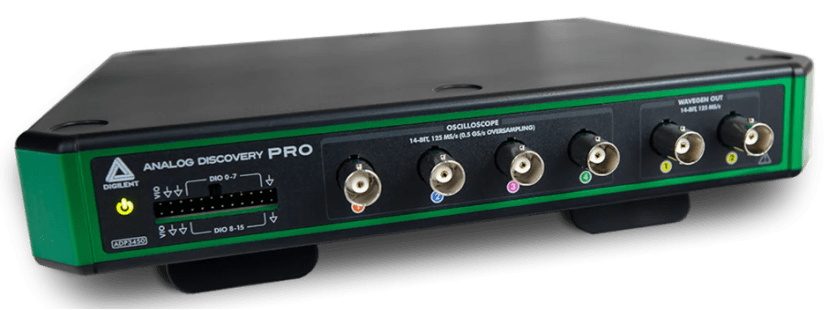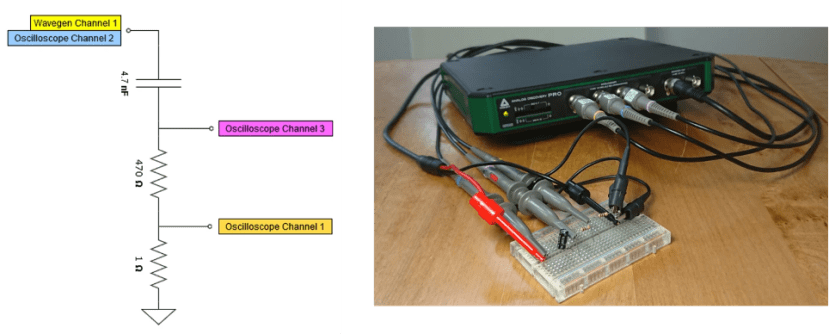Measure the power with a portable mixed signal oscilloscope
Follow articleHow do you feel about this article? Help us to provide better content for you.
Thank you! Your feedback has been received.
There was a problem submitting your feedback, please try again later.
What do you think of this article?
Measuring the power consumption of an RC circuit is easy if you use the WaveForms software together with the Analog Discovery Pro oscilloscope, both from Digilent. As oscilloscopes only measure voltages, this project uses a sensing resistor to calculate the circuit’s power with the help of the Math channels of the oscilloscope. From this, it is easy to determine the power of the resistor and the capacitor.
Digilent's Analog Discovery Pro (222-2681) comes in two variants: as a two-channel or as a four-channel high-resolution oscilloscope with a resolution of 14 bits and a sampling rate of up to 0.5 GSamples/s. With its 16 digital channels, the Analog Discovery Pro is a genuine mixed-signal oscilloscope. It also has a digital power supply, digital outputs, two external trigger inputs, and a two-channel arbitrary waveform generator. Users can control them through the free WaveForms software, which includes twelve different instruments ready to analyze mixed-signal systems.
This software, once connected through USB to Digilent’s portable oscilloscope, logic analyzer, and function generator products like the Analog Discovery Pro, enables analog and digital design on your personal computer through a powerful suite of instruments. WaveForms has a clean, easy-to-use graphical interface for each instrument and simplifies the acquisition, storage, analysis, visualization, and the creation and reuse of analog and digital signals.
Hardware Setup
Start by building the circuit as shown in the image and connect the output of the waveform generator as suggested. Make sure to attach the probes to ground, they are single-ended.
Virtual Instrumentation
Set the Wavegen instrument to create a sine wave with a frequency of 20 kHz and an amplitude of 5 V.
Next open the Scope instrument and enable the channels 1, 2, and 3. Adjust the range of channel 1 to 5 mV/div and the ones of channels 2 and 3 to 1 V/div and set the time base to 10 µs/div. Click on "Run all instruments" to start the Wavegen instrument and the Scope instrument simultaneously.
Now you can calculate the current and the power. Add a Math channel to the oscilloscope using the "Add Channel" dropdown menu and select "Custom" as type; WaveForms will plot it in the same window as the voltage measurement. A new window will show. Here, enter "(C2-C1)*C1/Rs". Rs is the value of the sensing resistor. This instructs the Math channel to subtract the voltage measured by channel 1 from the voltage of channel 2, giving the voltage over the RC element, which is then multiplied by the current through the system. Set the Unit to "W" and the range to 20 mW/div.
Calculating the power of the resistor follows the same scheme: Add another Math channel and enter "(C3-C1)*C1/Rs" in the dialog. Otherwise, use the same settings as before.
If you are interested in the capacitor's power, subtract the voltage over the resistor and the shunt from the voltage across the circuit and multiply the result by the circuit's current. Add a third Math channel with a range of 1 mW/div for that.
The channels might be noisy, but you can average each signal over multiple samples. Go to "View" → "Measurements" and add a "Defined Measurement". First, select "Math1" → "Vertical" and highlight "Average". Click an "Add" and repeat this for the other two Math Channels. Finally, close the dialog.
A full guide to this project is available on the Digilent Reference Page.







